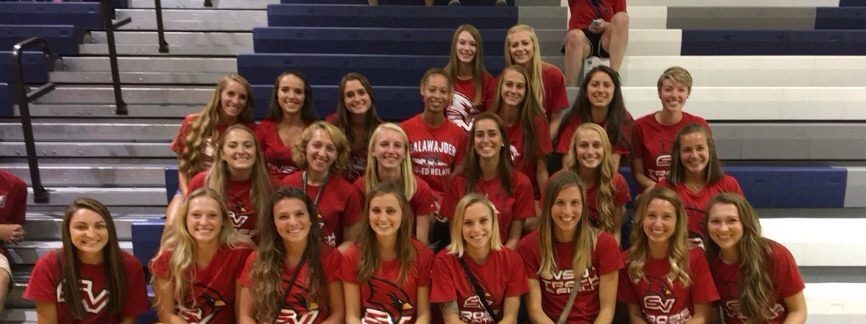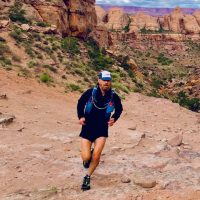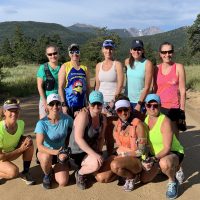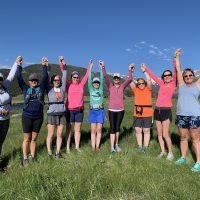We return to Saginaw Valley State University (SVSU) this week where Angelina Ramos, head coach of the women’s distance running team, recounts how her athletes fared in the 2016 Great Lakes Intercollegiate Athletic Conference (GLIAC) championships following a disappointing start to the season. With confidence low and her reputation at stake, Angelina knew that change was needed. Here Angelina reveals some of the initial difficulties she encountered, her efforts to restore belief within the team, and how only small changes were needed to achieve big outcomes on race day!
Underperformed is an understatement, Coach. We’ve got one of the best indoor track facilities in the state of Michigan—people EXPECT us to do great things because we have this. I have to answer to the Athletic Director, to alumni… That’s the worst I’ve ever seen them look! We red-shirted a handful of athletes last year with the hopes that this year was going to be our big year…
There are some types of failure that eat away at you. Your mind starts to play tricks on you, whispering that your efforts have been in vain, taunting your deepest insecurities. Head Coach Cowan’s words echoed through my mind for weeks. I felt like a child, hiding behind my clipboard, avoiding eye contact. My tears betrayed me. He was probably questioning why he’d taken a chance on hiring me, sacrificing his own validity by having two paid distance coaches on staff against any athletic director’s wishes, with the other being a former professional US distance runner and six-time Olympic Trials qualifier—my fiancé, the men’s distance coach. I yearned to show him my improvement charts for the girls—how their workouts showed they were in better shape than that race exposed. But there is no hiding in track and field. The sport is raw, and you always know where you rank or stack up to anyone else, whether from this decade or any other—the numbers never lie. I had let my girls down.
I appreciate your success with the young girls, Coach, I really do. But they’re a year away from scoring points for us at a championship meet. At the end of the day, our top three girls on the highest paid scholarships that the program has to offer didn’t get it done!
In January of 2015, Saginaw Valley State University Head Coach Cowan brought me on staff, hoping a female distance coach with NCAA Division I experience could revive his women’s distance program. They had failed to qualify for 2014’s cross-country nationals for the first time after a three-year streak of consistently contending, and their best runner had barely broken the top 100 finishers in fall 2014. I’d given each girl an intake form to fill out, asking them about their history of injury, their goals, what motivated them, to get to know them better, to meet them where they were, and to build them up from that point. I was shocked to get back a stack of papers detailing everything from undiagnosed eating disorders to struggles with confidence. The pages bled before me, recounting feelings of “not deserving” to be competing at a high level and of “losing their love for running because of constant comparison to others and of never feeling good enough,” even from national-level qualifiers and conference champions. I read admissions of losing passion for coming to practice, frustrations with repeat injuries, and lost belief in their high school selves. The negative self-talk was rampant, and the entire culture had to be rebuilt. I had a big job to do, and it started with getting the girls to believe in themselves and love the sport again, and to enjoy being present at practice. Hope still remained—the girls had filled those intake forms out honestly as a cry for help, and I aimed to give it to them—it’s why I’d become a coach in the first place!
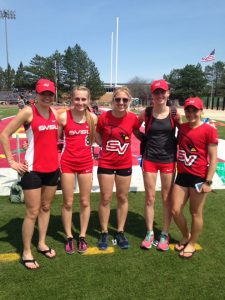 Previously, SVSU had only finished as high as sixth nationally in the women’s distance medley relay. Across six months, I’d coached Chantelle, Brittany, and Taylor to break SVSU’s former school record in the DMR (distance medley relay) by 15 seconds and solidify themselves as one of the best DMR teams nationwide by taking third at 2015’s national indoor championships. Chantelle ran 3:30 for 1200m, a sprinter named Kim ran 59 for 400m, Brittany ran 2:12 for 800m and Taylor closed the mile in 4:45. Only one of those ladies graduated: Chantelle. To any outsider looking in, the 2016 indoor season was in the bag once four-time All-American Emily Short was back in a singlet (she had redshirted the previous season). The 2016 indoor squad had the makings of a relay team that could win, let alone repeat as All-Americans (the top eight nationally at any event).
Previously, SVSU had only finished as high as sixth nationally in the women’s distance medley relay. Across six months, I’d coached Chantelle, Brittany, and Taylor to break SVSU’s former school record in the DMR (distance medley relay) by 15 seconds and solidify themselves as one of the best DMR teams nationwide by taking third at 2015’s national indoor championships. Chantelle ran 3:30 for 1200m, a sprinter named Kim ran 59 for 400m, Brittany ran 2:12 for 800m and Taylor closed the mile in 4:45. Only one of those ladies graduated: Chantelle. To any outsider looking in, the 2016 indoor season was in the bag once four-time All-American Emily Short was back in a singlet (she had redshirted the previous season). The 2016 indoor squad had the makings of a relay team that could win, let alone repeat as All-Americans (the top eight nationally at any event).
Hillsdale’s team had won the year before, but Saginaw Valley was the only team that worried them. Hillsdale’s coach pulled their women aside at the indoor Great Lakes Intercollegiate Athletic Conference (GLIAC) championship meet and warned, “I don’t want Emily Oren [their final relay leg, and a steeplechase USA Olympic Trials qualifier] worried about Taylor Stepanski when she gets the baton. You get her that baton out of harm’s way!” They nodded in unison.
Except they needn’t have worried. SVSU’s DMR team, which was expected to contend for first place in the US against the best runners in Division II, never even made it to nationals.
To add salt to an open wound, the only female distance qualifier for the national meet limped through the final 200 meters of the race to finish last in the 800m final. Just a week before, Taylor had run 500m in 75 seconds sitting on Coach Jason Hartmann’s shoulder—a six-time All-American for the University of Oregon—as he paced her through her workout. I beamed at my stopwatch as she followed that up with a 300m in 46 seconds after only 60 seconds of recovery, urging her on as she chased my fiancé around SVSU’s Bynum red indoor track—an indoor facility that rivaled those of most Division I programs. Taylor should have been able to hang on to a field going out in 59 seconds, but instead, her piriformis pinched up when it was time to start moving. When I went to meet her in the center of the field, I put on my diplomat’s face and prepared to be what she needed at that moment. But as soon as she accepted her All-American award and left to cool down, I cried in the bathroom for what felt an eternity, racking my brain to decode the mystery of what had happened and why her piriformis kept nagging her so. I couldn’t forgive myself for failing an athlete who most needed a performance to build confidence towards competition at that level. I had forgotten that failure could hurt so badly, putting you in a mental hell of sleepless nights for weeks at a time when you need to be strongest for those looking to you for answers, counting on you to bring them back to the light.
Fast forward two months. It was the last week of April and a return to the GLIAC championships—a time to redeem ourselves from a season of “good, but not good enough.” After some minor tweaks in training, subtle program changes, the addition of guided visualization sessions using activacuity, and getting my athletes in front of health professionals to correct longstanding injuries, I believed they were ready.
“Believe in yourself as I believe in you…go fly little Cardinal.” Pulling them in for a hug, I whispered this to each before they toed the line.
Christina, plagued with plantar fasciitis for months on end, set the tone early, scoring her first ever points at a conference meet in the 3k steeplechase, despite the water barrier getting stuck at the men’s height for the women’s race. A week before that, she’d had one of the worst races of her life, slower than even the first steeplechase she’d ever ran as a freshman. But Christina didn’t let a past event define the present moment—she found a mental calm within and went into the race with intention: score a point at conference (top 8). The year before, she had been out-kicked on the home stretch, collapsing across the line for ninth. She had 100 excuses for not racing well—she had been sick, workouts that hadn’t gone as planned because of the plantar—but instead, she rose to the occasion and scored the team’s first point of the day. She set a trend for the younger girls that the head coach had thought to be “a year away from scoring points at the conference meet.” But I felt different, and one by one they proved me right.
Confident after running a personal best 5k time of 17:38 the week before, Allison was up next to race her first ever 10k: 25 laps around the oval circle. The gutsy freshman ended up running 37:21 for 10k, scoring sixth, then coming back less than 24 hours later to score eighth in the 5k in 90 degrees sweltering heat, no shade, and 86 percent humidity. It was a battle of grit that seven other competitors lost that day, having dropped out of the race altogether. Allison hung on and climbed them one by one. I had given her a choice: to decide the morning of running the 10k whether she had another race in her—she had to decide before she toed the line. Allison could either scratch the 5k altogether if she was feeling exhausted from racing the day before, or she could toe the line with intention and mentally out-grit her competitors. My heart filled with happiness when I saw her start warming up 50 minutes before the 5k race would go off—she had committed, she was all in. The routine they’d done a thousand times before—a two-mile warm-up, six drills, six descending pace strides, the first four in training shoes, the last four in racing shoes—her body knew what was coming, it was ready for battle. She may have come in eighth overall in that 5k, but mentally, she won the day. She was scared going in, but she refused to let fear of doing something that none of her teammates were attempting—the 10k/5k double less than 24 hours apart—scare her from executing her race plan.
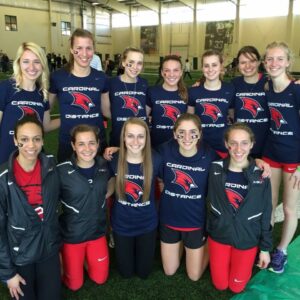 Taylor had won the 800m a few years in a row, even with a broken arm and shoulder the year before. She had stood on the podium with her arm in a sling and a medal around her neck with a big toothy grin. While that should have given her belief that she’s as tough as nails and is willing to hurt mid-race in ways most other competitors are scared to, it hadn’t given her the confidence that she could contend with the best in the nation. At nationals the year before, because of the arm break, her balance was off, and she fell halfway through the 800m in such a way that she couldn’t finish the race, and the experience embarrassed her, devastated her, and affected her motivation for the entire summer putting her into a hard depression. This year, I wanted to prepare her mentally for nationals by getting her in a race where she wasn’t guaranteed the win. An event where she could test herself against the country’s best BEFORE the national meet, so that it would not be such an overwhelming and daunting task.
Taylor had won the 800m a few years in a row, even with a broken arm and shoulder the year before. She had stood on the podium with her arm in a sling and a medal around her neck with a big toothy grin. While that should have given her belief that she’s as tough as nails and is willing to hurt mid-race in ways most other competitors are scared to, it hadn’t given her the confidence that she could contend with the best in the nation. At nationals the year before, because of the arm break, her balance was off, and she fell halfway through the 800m in such a way that she couldn’t finish the race, and the experience embarrassed her, devastated her, and affected her motivation for the entire summer putting her into a hard depression. This year, I wanted to prepare her mentally for nationals by getting her in a race where she wasn’t guaranteed the win. An event where she could test herself against the country’s best BEFORE the national meet, so that it would not be such an overwhelming and daunting task.
Taylor was stronger than all of the competition in our conference in the 800m, but she wasn’t in the 1500m. The head coach disagreed with taking Taylor—a high point scoring scholarship athlete—out of the 800m, her main event where she was guaranteed to score needed points. But he let me execute our 1500m plan anyhow, believing it necessary for event-area coaches to own their strategic decision-making, for better or for worse. Our goal was not to be cowed by any of the Grand Valley State or Hillsdale All-American studs the way she had been at an indoor mile event earlier that year and to break the school 1500m record of 4:26. Taylor went into the race seeded seventh with a 4:29 best time from earlier that month. One of the other teams set up a rabbit to pull the race out fast in a 400m split time of 66. Taylor went with it, tucked into second place early on, practicing aggressive patience. This early leader fell off at half-way, and when a pack went around her to capitalize on the fast early pace, Taylor was willing to hurt. She never hesitated and went with them. Taylor overcame the fear that had affected her during that winter mile race when she was scared to cover the move about halfway in. This time, it was instinctive, automatic, and she never doubted herself. Taylor finished the race in second, passing a multiple-time All-American senior at Hillsdale while sprinting down the home stretch, setting a new school record of 4:23.22, shattering the old one by three seconds! She missed first place by less than a second.
In that same 1500m race, her teammate Alicia also tasted some of the magic. In 2015, the slowest time that advanced from 1500m conference prelims to the finals 24 hours later was a 4:46. Alicia, a freshman, had a personal best time of 4:48 going into the conference meet. Despite that, I knew she could outsmart the other runners and run from the back to sneak into the final. There were about 12 females in each heat, and the top three auto-advanced to the final the next day. Alicia stuck to the plan, running 4:44 in the prelim, taking third in her heat, and auto-advancing to the finals where 12 athletes would toe the line. Alicia had one of the slowest 800m personal bests in the field but was an incredibly strong runner. I knew if she went out sub 72 seconds that first lap with the leaders, the race would be over before it began. So we adopted a different strategy. During lap one, Alicia would run in 12th place, during lap two, in 11th place, during lap three, in 10th place, and during lap four, in 9th place, until the last 80 meters of the race where she would attack like an animal. She executed this more perfectly than I ever could have imagined. With 300m left and Alicia sitting in 9th place, I could see her thinking “it’s now or never,” before shooting out like a gun to run down 8th place. She caught 8th place with 35 meters left and held onto it with everything she had inside. Her sneak attack for eighth meant her scoring her first ever point at a conference championship meet.
Next up was the 800m crew. Two years ago, Paige had been depressed and hating track and field altogether because she was competing as a multi-event heptathlete, wasn’t having much success, and was always getting injured. After watching her run and knowing that Paige was a 300m hurdles specialist in high school, I’d talked to her and the head coach about Paige switching groups and training under me for the 400m/800m. Throughout that time, Paige progressed from completing her first ever 800m run in 2:23 to running 2:12 in the 800m finals of the outdoor conference championships to score fifth overall. She had a lot of success that season because she went into each race committed to curiosity and to finding out what she could do.
As we came into the 2016 season, suddenly now on scholarship increase, Paige felt like “everyone” had high expectations of her that she had to live up to, and put a lot of pressure on herself going into races. The fear of failure and performance anxiety had increased to the point where she could only relax by practicing separately from the rest of the team, thereby preventing any comparisons with her twin, Taylor, or other teammates. We redshirted her for the indoor track season because Paige would cry before a race, hid in the locker room, and missed the start of her first two races. She wanted to know what she was capable of before the first race. So we began having time trials in practice where she ran against myself or our former-All-American 400m hurdles/sprinter coach Dennis Martins. We supplemented this with using activacuity to focus on calming her breathing and reminding herself of her positives before going into a race.
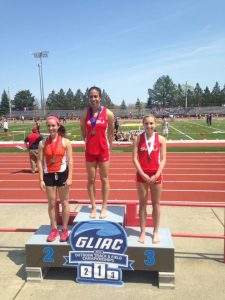 As Paige went into 2016’s outdoor conference championships, she again went into a situation where managing “expectations” challenged her. At the 2016 indoor championships, Paige’s twin, Taylor, had won the conference 800m and another SVSU teammate Deanna had taken third, with Findlay’s Samantha Grippe in second. Taylor had won the indoor or outdoor conference 800m title the last three years in a row and was the defending champion. If the defending champion wasn’t racing the 800m anymore, that meant the win was up for grabs for another team—or at least that’s what the competition was thinking going into the meet.
As Paige went into 2016’s outdoor conference championships, she again went into a situation where managing “expectations” challenged her. At the 2016 indoor championships, Paige’s twin, Taylor, had won the conference 800m and another SVSU teammate Deanna had taken third, with Findlay’s Samantha Grippe in second. Taylor had won the indoor or outdoor conference 800m title the last three years in a row and was the defending champion. If the defending champion wasn’t racing the 800m anymore, that meant the win was up for grabs for another team—or at least that’s what the competition was thinking going into the meet.
Both Paige and Deanna prepared for battle. They handled the pressure well knowing that they had to step up against the GLIAC competition and that it was on one of them to get the job done and make up those points. Paige knew her family and her boyfriend’s parents were in the stadium rooting for her. The crowd went quiet, sweat slid down their faces, and the gun went off. Findlay’s Samantha Grippe ran valiantly, leading from the gun, pulling the race out in 62.4 seconds. Paige and Deanna went out in sixth and seventh and climbed the field from 300m through 500m. Going into the 600m mark, Paige and Deanna were in perfect position in third and fourth to strike when they needed to. Our plan was for Deanna and Paige to “sit and kick,” a strategy we had rehearsed in practice many times before. It involved running at a controlled pace for a sustained period, before suddenly switching up through the gears to the finish and leaning across the line dramatically right at the end. Findlay’s Samantha Grippe, Deanna, and Paige pulled away from the rest of the field by a clear 30 meters with 150 meters left of the race. Deanna and Paige chased Samantha down, attacking the last 130 meters. They were neck and neck as they approached the finish line with 20 meters to go. Deanna ran 2:11.311 for the win, out-kicking Grippe’s 2:11.312, with Paige right behind in 2:11.313 for third. It was a photo finish if there ever was one! Paige had earned her spot on the podium for the first time, and Deanna, being a senior, had concluded her collegiate career as a conference champion! Paige had bounced back from the dark place into which she had fallen during the winter to reach a higher point than she’d ever been!
At the end of the meet, Coach Cowan walked up to me and gave me a huge high-five. Great Job, Coach!
The Cardinal women had scored 53.5 points—the most points ever scored in program history at an outdoor conference championship meet on the women’s or men’s side, and 95% of the point scoring came from the distance/middle distance women’s group—our group. The tide was turning. Our mascot may be the cardinal, but that week, they were phoenix, rising from the ashes, flying again in all their glory.
activacuity provides a daily dose of positive guided imagery sessions that can be used individually or in a team or group setting to facilitate athletic performance. Find out what you, or your team, can do when you make that mind-body connection – check out our subscription options here.

